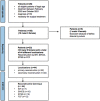The Value of Negative-Pressure Wound Therapy and Flap Surgery in Hidradenitis Suppurativa - A Single Center Analysis of Different Treatment Options
- PMID: 35836613
- PMCID: PMC9273893
- DOI: 10.3389/fsurg.2022.867487
The Value of Negative-Pressure Wound Therapy and Flap Surgery in Hidradenitis Suppurativa - A Single Center Analysis of Different Treatment Options
Abstract
Background: Hidradenitis suppurativa is manifested by painful abscesses and scarring of sweat glands. Axillary, inguinal and genital regions are mostly affected. Multiple options exist in the treatment of hidradenitis suppurativa. The aim of this retrospective, mono-center cohort study was to analyze the outcome of different treatment methods after radical excision of hidradenitis suppurativa.
Methods: We retrospectively evaluated the treatment strategy and recurrence rate of hidradenitis suppurativa. We included all eligible patients of legal age between February 2003 and October 2021, with the diagnosis of Hidradenitis suppurativa and the necessity for surgical treatment. All patients with surgical treatment and direct wound closure by suture were excluded. Bacterial load and flora were analyzed for primary and secondary reconstruction in combination with negative-pressure wound therapy. Patient data were analyzed for recurrence rate and remission time according to different reconstructive techniques.
Results: In 44 affected anatomical sites (n = 23 patients) we treated 15 patients with negative-pressure wound therapy. Bacterial load and flora were lower in the last wound swab of patients with multi-surgical procedures (22 localizations) compared to the first wound swab independent of the use of negative-pressure wound therapy.Wound closure, independent of a direct and multi-stage procedure was achieved by local fasciocutaneous flaps (n = 12), secondary intention healing (n = 7), secondary intention healing with buried chip skin grafts (n = 10), or split-thickness skin grafts (n = 15). Radical excision combined with split-thickness skin grafts showed the lowest recurrence rate in the follow-up (16%; n = 4).
Conclusion: Radical excision of hidradenitis suppurativa as gold standard for surgical treatment combined with negative-pressure wound therapy as multi-stage procedures ultimately reduced bacterial load and flora in our study. The use of split-thickness skin grafts showed the lowest recurrence rate.
Keywords: acne inversa; bacterial burden; flap surgery; hidradenitis suppurativa; negative-pressure wound therapy.
Copyright © 2022 Stumpfe, Horch, Arkudas, Cai, Mueller-Seubert, Hauck and Ludolph.
Conflict of interest statement
R. E. H. has received third party funding for scientific research on NPWT from KCI—an Acelity company in the past and has served as a member of a Scientific Advisory Board of KCI-Acelity in the past. R. E. H. and A. A. served as speakers on scientific symposia of KCI-Acelity in the past. The authors have no other relevant affiliations or financial involvement with any organisation or entity with a financial interest in or financial conflict with the subject matter or materials discussed in the manuscript apart from those disclosed.
Figures



Similar articles
-
Negative pressure wound therapy, staged excision and definitive closure with split-thickness skin graft for axillary hidradenitis suppurativa: a retrospective study.J Wound Care. 2017 Jan 2;26(Sup1):S36-S42. doi: 10.12968/jowc.2017.26.Sup1.S36. J Wound Care. 2017. PMID: 28105901
-
Hidradenitis Suppurativa: A Comparison of Institutional Experience and the Tracking Operations and Outcomes for Plastic Surgeons Registry.Plast Reconstr Surg. 2022 May 1;149(5):1216-1224. doi: 10.1097/PRS.0000000000009024. Epub 2022 Mar 18. Plast Reconstr Surg. 2022. PMID: 35311802
-
Surgical approach to extensive hidradenitis suppurativa in the perineal/perianal and gluteal regions.World J Surg. 2009 Mar;33(3):481-7. doi: 10.1007/s00268-008-9845-9. World J Surg. 2009. PMID: 19067039
-
The role of negative pressure wound therapy in the management of hidradenitis suppurativa: a case report and literature review.Int Wound J. 2017 Feb;14(1):35-39. doi: 10.1111/iwj.12544. Epub 2015 Dec 13. Int Wound J. 2017. PMID: 26663439 Free PMC article. Review.
-
Hidradenitis Suppurativa and Wound Management.Int J Low Extrem Wounds. 2015 Sep;14(3):236-44. doi: 10.1177/1534734615598890. Epub 2015 Aug 6. Int J Low Extrem Wounds. 2015. PMID: 26248827 Review.
Cited by
-
The Value of a Modified Posterior Thigh Flap with Z-Plasty for Reconstruction of Ischial Tuberosity Pressure Ulcers: A Retrospective Single Center Analysis.Life (Basel). 2025 Jan 22;15(2):146. doi: 10.3390/life15020146. Life (Basel). 2025. PMID: 40003555 Free PMC article.
-
Is Instillational Topical Negative Pressure Wound Therapy in Peri-Prosthetic Infections of the Breast Effective? A Pilot Study.J Pers Med. 2022 Dec 13;12(12):2054. doi: 10.3390/jpm12122054. J Pers Med. 2022. PMID: 36556274 Free PMC article.
-
Hidradenitis Suppurativa: Dermatopathological Insights and Surgical Success Strategies.Skin Res Technol. 2024 Sep;30(9):e70069. doi: 10.1111/srt.70069. Skin Res Technol. 2024. PMID: 39300807 Free PMC article. No abstract available.
-
Analysis of laboratory markers in body contouring procedures after bariatric surgery does not indicate particular risks for perioperative complications.Perioper Med (Lond). 2024 Jun 27;13(1):63. doi: 10.1186/s13741-024-00422-7. Perioper Med (Lond). 2024. PMID: 38937810 Free PMC article.
References
LinkOut - more resources
Full Text Sources

